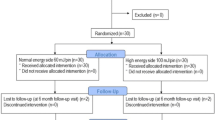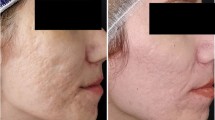Abstract
Fractional microneedling radiofrequency (FMR) is one of the promising methods in acne treatment. Moreover, bipolar radiofrequency (BR) generates heat thereby which induces neocollagenosis. FMR may have the potential to be a safe and effective treatment for the patients both with acne and acne scar. This study was performed to compare the efficacy and safety of FMR and BR in acne and acne scar treatment. Furthermore, mechanism of the FMR treatment was investigated through skin tissues obtained from subjects. Twenty subjects with mild-to-moderate acne and acne scars were treated in a split-face manner with FMR and BR. Two sessions of treatment was done 4 weeks apart in a total 12-week prospective single-blind, randomized clinical trial. Clinical assessment and sebum measurement were carried out for the evaluation of efficacy and safety. Skin tissues were acquired for investigation of molecular changes. FMR was more effective for acne scar especially in icepick and boxcar scar compared to BR. Both inflammatory and non-inflammatory acne lesions decreased by 80 and 65 % in the FMR-treated side at the final visit of 12 weeks, respectively. FMR treatment resulted in significant reduction of sebum excretion. Both treatments showed no severe adverse effects other than erythema. The FMR showed superior efficacy in acne and acne scar compared with BR. Increased expression of TGFβ and collagen I and decreased expression of NF-κB, IL-8 are suggested to involve in the improvement of acne scar and acne lesion by FMR.





Similar content being viewed by others
References
Abd El All HS, Shoukry NS, El Maged RA, Ayada MM (2007) Immunohistochemical expression of interleukin 8 in skin biopsies from patients with inflammatory acne vulgaris. Diagn Pathol 2:4
Burns JA (2005) Thermage: monopolar radiofrequency. Aesthet Surg J 25(6):638–642
Choi YS, Suh HS, Yoon MY, Min SU, Lee DH, Suh DH (2010) Intense pulsed light vs. pulsed-dye laser in the treatment of facial acne: a randomized split-face trial. J Eur Acad Dermatol Venereol 24(7):773–780
Cordeiro MF, Bhattacharya SS, Schultz GS, Khaw PT (2000) TGF-beta1, -beta2, and -beta3 in vitro: biphasic effects on Tenon’s fibroblast contraction, proliferation, and migration. Invest Ophthalmol Vis Sci 41(3):756–763
Dreno B, Khammari A, Orain N et al (2007) ECCA grading scale: an original validated acne scar grading scale for clinical practice in dermatology. Dermatology 214(1):46–51
Fitzpatrick R, Geronemus R, Goldberg D, Kaminer M, Kilmer S, Ruiz-Esparza J (2003) Multicenter study of noninvasive radiofrequency for periorbital tissue tightening. Lasers Surg Med 33(4):232–242
Goodman G (2006) Acne-natural history, facts and myths. Aust Fam Physician 35(8):613–616
Hantash BM, Ubeid AA, Chang H, Kafi R, Renton B (2009) Bipolar fractional radiofrequency treatment induces neoelastogenesis and neocollagenesis. Lasers Surg Med 41(1):1–9
Harper JC, Thiboutot DM (2003) Pathogenesis of acne: recent research advances. Adv Dermatol 19:1–10
Hruza G, Taub AF, Collier SL, Mulholland SR (2009) Skin rejuvenation and wrinkle reduction using a fractional radiofrequency system. J Drugs Dermatol 8(3):259–265
Huang S, Robinson JB, Deguzman A, Bucana CD, Fidler IJ (2000) Blockade of nuclear factor-kappaB signaling inhibits angiogenesis and tumorigenicity of human ovarian cancer cells by suppressing expression of vascular endothelial growth factor and interleukin 8. Cancer Res 60(19):5334–5339
Jacob CI, Dover JS, Kaminer MS (2001) Acne scarring: a classification system and review of treatment options. J Am Acad Dermatol 45(1):109–117
Janiczek-Dolphin N, Cook J, Thiboutot D, Harness J, Clucas A (2010) Can sebum reduction predict acne outcome? Br J Dermatol 163(4):683–688
Jung JY, Choi YS, Yoon MY, Min SU, Suh DH (2009) Comparison of a pulsed dye laser and a combined 585/1064-nm laser in the treatment of acne vulgaris. Dermatol Surg 35(8):1181–1187
Kaminaka C, Uede M, Matsunaka H, Furukawa F, Yamomoto Y (2014) Clinical evaluation of glycolic acid chemical peeling in patients with acne vulgaris: a randomized, double-blind, placebo-controlled, split-face comparative study. Dermatol Surg 40(3):314–322
Kim SE, Lee JH, Kwon HB, Ahn BJ, Lee AY (2011) Greater collagen deposition with the microneedle therapy system than with intense pulsed light. Dermatol Surg 37(3):336–341
Leyden JJ (1997) Therapy for acne vulgaris. N Engl J Med 336(16):1156–1162
Lu L, Saulis AS, Liu WR et al (2005) The temporal effects of anti-TGF-beta1, 2, and 3 monoclonal antibody on wound healing and hypertrophic scar formation. J Am Coll Surg 201(3):391–397
Min S, Yoon JY, Park SY, Kwon HH, Suh DH (2014) Clinical effect of bovine amniotic membrane and hydrocolloid on wound by laser treatment: prospective comparative randomized clinical trial. Wound Repair Regen 22(2):212–219
Monaco C, Andreakos E, Kiriakidis S et al (2004) Canonical pathway of nuclear factor kappa B activation selectively regulates proinflammatory and prothrombotic responses in human atherosclerosis. Proc Natl Acad Sci 101(15):5634–5639
Montesi G, Calvieri S, Balzani A, Gold MH (2007) Bipolar radiofrequency in the treatment of dermatologic imperfections: clinicopathological and immunohistochemical aspects. J Drugs Dermatol 6(9):890–896
O’Brien S, Lewis J, Cunliffe W (1998) The Leeds revised acne grading system. J Dermatol Treat 9(4):215–220
Peterson JD, Palm MD, Kiripolsky MG, Guiha IC, Goldman MP (2011) Evaluation of the effect of fractional laser with radiofrequency and fractionated radiofrequency on the improvement of acne scars. Dermatol Surg 37(9):1260–1267
Prieto VG, Zhang PS, Sadick NS (2005) Evaluation of pulsed light and radiofrequency combined for the treatment of acne vulgaris with histologic analysis of facial skin biopsies. J Cosmet Laser Ther 7(2):63–68
Ruiz-Esparza J, Gomez JB (2003) Nonablative radiofrequency for active acne vulgaris: the use of deep dermal heat in the treatment of moderate to severe active acne vulgaris (thermotherapy): a report of 22 patients. Dermatol Surg 29(4):333–339
Sadick NS, Makino Y (2004) Selective electro-thermolysis in aesthetic medicine: a review. Lasers Surg Med 34(2):91–97
Yoon JY, Kwon HH, Min SU, Thiboutot DM, Suh DH (2013) Epigallocatechin-3-gallate improves acne in humans by modulating intracellular molecular targets and inhibiting P. acnes. J Invest Dermatol 133(2):429–440
Zouboulis CC, Seltmann H, Hiroi N et al (2002) Corticotropin-releasing hormone: an autocrine hormone that promotes lipogenesis in human sebocytes. Proc Natl Acad Sci 99(10):7148–7153
Acknowledgments
This work was supported by the National Research Foundation of Korea (NRF) grant funded by the Korea government (MSIP) (No. 2014R1A2A1A11049397) as well as Seoul National University Hospital Research Fund (No. 0620141990).
Author information
Authors and Affiliations
Corresponding author
Ethics declarations
Conflict of interest
The authors declared no conflicting interests.
Rights and permissions
About this article
Cite this article
Min, S., Park, S.Y., Yoon, J.Y. et al. Comparison of fractional microneedling radiofrequency and bipolar radiofrequency on acne and acne scar and investigation of mechanism: comparative randomized controlled clinical trial. Arch Dermatol Res 307, 897–904 (2015). https://doi.org/10.1007/s00403-015-1601-z
Received:
Revised:
Accepted:
Published:
Issue Date:
DOI: https://doi.org/10.1007/s00403-015-1601-z




